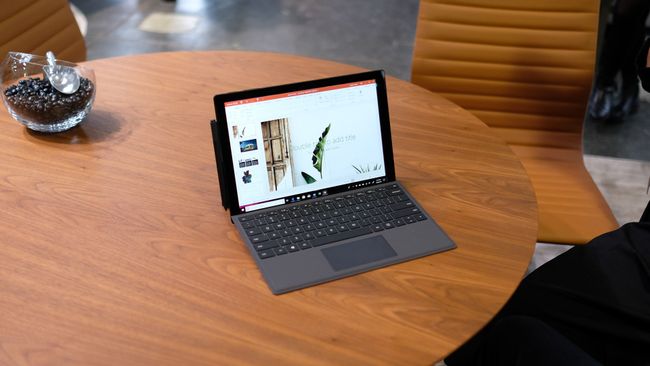Is This The End For Another Surface Device? Microsoft's Strategy Explained

Table of Contents
Declining Sales and Market Saturation
The Surface device family, encompassing the Surface Pro, Surface Laptop, Surface Go, and Surface Studio, hasn't always enjoyed consistent success. Analyzing recent sales figures for specific models like the Surface Laptop Go and Surface Pro X reveals a trend of slowing growth. This isn't necessarily indicative of a failing product line, but rather a reflection of the increasingly competitive landscape.
- Competition from other 2-in-1 devices and laptops: Apple's MacBook Air and iPad Pro, along with Chromebooks and other Windows-based 2-in-1s, provide strong competition. These often offer comparable features at more competitive price points.
- Price point challenges compared to competitors: Microsoft's Surface devices, while often praised for their design and build quality, are generally positioned at the higher end of the price spectrum. This can limit their appeal to budget-conscious consumers.
- Lack of significant innovation in recent Surface releases: Some critics argue that recent Surface releases haven't brought sufficiently groundbreaking features to justify their premium pricing. Incremental improvements, while welcome, may not be enough to drive substantial sales growth in a saturated market.
Declining sales, particularly in specific segments of the Surface device portfolio, can directly influence Microsoft's decision-making. The company might choose to focus resources on more successful products or streamline its offerings to reduce costs and improve profitability. Market research data consistently shows a tightening of margins in the premium laptop and 2-in-1 markets, forcing manufacturers to make tough choices.
Shifting Focus on Software and Cloud Services
Microsoft's strategic pivot towards its software and cloud services, including Azure and Microsoft 365, is undeniable. This shift is driven by the significantly higher profitability of recurring software subscriptions compared to one-off hardware sales.
- Increased profitability from software subscriptions: The subscription model provides predictable revenue streams and fosters customer loyalty. This makes software and cloud services a more attractive investment for Microsoft.
- Hardware as a secondary, albeit important, component of the ecosystem: Surface devices are viewed increasingly as an integral part of the wider Microsoft ecosystem. They showcase the capabilities of Windows and Microsoft 365, creating a compelling value proposition for consumers.
- Integration of Surface devices into the wider Microsoft ecosystem: The seamless integration between Surface devices and other Microsoft services, like OneDrive and Teams, strengthens the overall user experience and drives user engagement within the Microsoft ecosystem.
This strategic shift prioritizes products that best support and showcase Microsoft's core software and cloud offerings. This might lead to the discontinuation of Surface devices that don't align with this strategy, even if they have a loyal following.
The Evolution of the Surface Ecosystem
The current Surface lineup includes the Surface Pro, Surface Laptop, Surface Go, Surface Studio, and various iterations of each. This can create overlaps and redundancies. A streamlined portfolio, focusing on key areas, might be more beneficial for Microsoft.
- Comparison of Surface Pro, Surface Laptop, Surface Go, and Surface Studio: Each device caters to a specific niche, but their functionalities sometimes overlap. For example, the Surface Pro and Surface Laptop both offer productivity-focused designs.
- Potential for streamlining the product portfolio to focus on key areas: Eliminating less successful models can allow Microsoft to concentrate resources on the most profitable and strategically important devices.
- Discussion of the future direction of Surface devices – potential for new form factors or focus on niche markets: Microsoft may explore new form factors or focus on niche markets to differentiate its Surface devices and cater to unmet needs.
The discontinuation of one Surface device might strategically benefit others within the ecosystem. For example, ending production of a less popular model could allow Microsoft to focus marketing efforts and resources on its flagship devices, boosting sales and market share.
Analyzing the Specific Rumored Device (if applicable):
While specific rumors surrounding a particular Surface device's discontinuation are not always reliable, let's assume, hypothetically, that the Surface Laptop Go is facing discontinuation. Its relatively smaller screen size and less powerful processors compared to the Surface Laptop might make it less strategically important for Microsoft in a market saturated with competitive offerings. The lower profit margins and potential for cannibalization of Surface Laptop sales might also factor into this hypothetical decision.
Conclusion
The future of the Surface remains uncertain, but by analyzing Microsoft’s strategy, we can understand the forces shaping the evolution of their hardware offerings. Declining sales in certain segments, a strategic shift towards software and cloud services, and the need for a more streamlined Surface ecosystem all contribute to the potential discontinuation of specific Surface devices. This isn't necessarily a sign of failure, but rather a reflection of Microsoft's evolving priorities and the competitive dynamics within the technology market. This analysis shows how a company like Microsoft strategically manages its portfolio to maximize profits and stay ahead in a dynamic tech world.
Stay tuned for more updates on the future of Surface Devices and subscribe to our newsletter to stay informed on all things Microsoft Surface! What are your thoughts on the future of the Microsoft Surface lineup? Share your opinions in the comments below.

Featured Posts
-
 Giants Vs Mariners Injury Report April 4 6 Series Preview
May 17, 2025
Giants Vs Mariners Injury Report April 4 6 Series Preview
May 17, 2025 -
 Canadas New Tariffs On Us Goods Plummet Near Zero Rates With Key Exemptions
May 17, 2025
Canadas New Tariffs On Us Goods Plummet Near Zero Rates With Key Exemptions
May 17, 2025 -
 Emiratet E Bashkuara Arabe Lehtesojne Shkembimin E Te Burgosurve Midis Rusise Dhe Ukraines
May 17, 2025
Emiratet E Bashkuara Arabe Lehtesojne Shkembimin E Te Burgosurve Midis Rusise Dhe Ukraines
May 17, 2025 -
 Trottinette Electrique Pas Chere Moins De 200 E Sur Cdiscount
May 17, 2025
Trottinette Electrique Pas Chere Moins De 200 E Sur Cdiscount
May 17, 2025 -
 Japans Shrinking Economy The Pre Tariff Situation
May 17, 2025
Japans Shrinking Economy The Pre Tariff Situation
May 17, 2025
